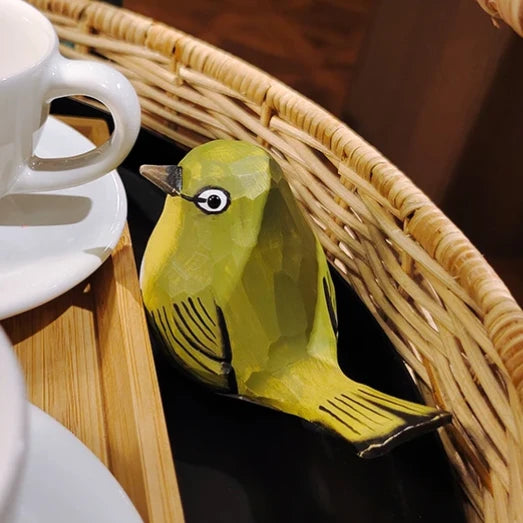
What to Know About Hand-Raising White-Eyes Birds (Zosterops): A Gentle Guide
Share
What to Know About Hand-Raising White-Eyes Birds (Zosterops): A Gentle Guide
 The White-Eyes bird (Zosterops), known for its soft chirping, adorable white eye ring, and charming personality, is becoming increasingly popular among bird lovers. These birds are small, curious, and social, making them rewarding to raise if cared for properly from a young age.
The White-Eyes bird (Zosterops), known for its soft chirping, adorable white eye ring, and charming personality, is becoming increasingly popular among bird lovers. These birds are small, curious, and social, making them rewarding to raise if cared for properly from a young age.
However, hand-raising White-Eyes is not as simple as raising larger parrots. Their tiny size, high energy, and sensitivity require careful planning. Here's what to keep in mind if you’re hand-raising a White-Eyes chick.
1. Choosing the Right Age to Start 🐣
White-Eyes chicks should ideally be hand-raised after they are at least 7–10 days old, when they are a bit stronger but still imprint easily.
Avoid very young hatchlings (under 5 days old) unless you're experienced and have proper equipment like an incubator and crop feeding tools.
2. Brooder Setup: Warm, Clean, and Secure 🌡️
Because of their small size, White-Eyes need a carefully controlled brooder environment.
-
Temperature: 32–35°C (90–95°F) in the first week, then decrease gradually.
-
Bedding: Use soft tissues or paper towels, changed daily.
-
Avoid slippery or damp surfaces—this can cause leg deformities or infections.
-
Keep the brooder quiet and safe from pets or strong airflow.
Tip: A small plastic box with a ventilated lid works well as a mini brooder.
3. Feeding White-Eyes: High Energy, Small Meals 🍼
 White-Eyes have a high metabolism and need to eat often in small portions.
White-Eyes have a high metabolism and need to eat often in small portions.
Use:
-
Nectar-like hand-feeding formula or baby bird food mixed with warm water.
-
Feed with a soft-tip syringe or micro spoon.
-
Add mashed fruits (banana, papaya) gradually as they grow.
-
Feed every 2–3 hours during the day for chicks under 3 weeks.
Always make sure food is lukewarm and not too thick. Their crop should slightly expand—not overfilled.
4. Cleanliness and Health Monitoring 🧼
Tiny birds are prone to illness if hygiene is neglected.
Ensure:
-
Tools and hands are sanitized before each feeding.
-
Brooder is clean and dry at all times.
-
Observe droppings: watery or discolored poop could signal digestive issues.
-
Any signs of lethargy, labored breathing, or crop problems require immediate vet care.
5. Socialization and Trust Building 💞
White-Eyes are highly social and can bond deeply with humans when raised by hand.
-
Talk softly and gently touch their head/back during feedings.
-
Once feathered, let them perch on your finger and fly short distances indoors.
-
Avoid harsh noises and sudden movements—these can cause stress or flight response.
As they grow, mirror companionship (or having other White-Eyes) helps prevent loneliness.
6. Weaning and Diet Transition 🍓
At around 4–5 weeks, your White-Eyes will begin pecking and showing interest in solid food.
Start offering:
-
Finch or softbill pellets
-
Sliced fruit (banana, papaya, apple)
-
Nectar mix in a small dish
-
Insects like fruit flies or mealworms for protein
Gradually reduce hand-feeding once they eat solids consistently. Patience is key.
7. Cage Setup and Environment 🏡
 White-Eyes need plenty of room to fly, perch, and explore. Their cage should include:
White-Eyes need plenty of room to fly, perch, and explore. Their cage should include:
-
Horizontal flying space
-
Natural branches or rope perches
-
Soft toys or leaves for enrichment
-
Small dishes for nectar, fruit, and clean water
-
A shallow bath dish—they love to bathe!
Let them fly indoors (safely) every day to stay healthy and happy.
8. Companionship and Long-Term Care 🕊️
White-Eyes are not solitary birds. If you hand-raise just one, ensure you give it daily social interaction or introduce a second White-Eyes after weaning.
They are gentle, but may become territorial with other bird species. Keep monitoring group dynamics if you house more than one.
Conclusion
Hand-raising a White-Eyes bird is a delicate yet joyful experience. Their sensitive nature, quick movements, and tiny size make them unique to raise—but with patience, warmth, and dedication, they grow into affectionate, lively companions.
A hand-raised White-Eyes will not just flutter around your home—they’ll win your heart with their curious gaze and cheerful songs.

















